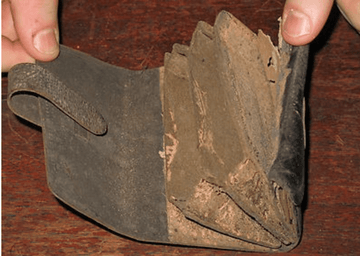Wallets are one of those everyday items we consistently interact with but often think little about. They are a functional item that keeps some of our most important things close at hand. Today, a wallet might carry ID’s, public transport cards, credit cards and cash. But even before the advent of a primarily cashless commerce system, people have been carrying around something resembling today’s wallet. The history of wallets is quite varied.
Let's break down what we are considering a wallet. For this historical exploration, we will consider a wallet as a small container worn on or near the body that holds the essentials or form of currency at the time.
The Ötzi Iceman
The Ötzi Iceman was found in 1991 in the Tyrolean Alps and is believed to be more than 5,000 years old, having lived in the early Copper Age. This male corpse was incredibly well preserved in a glacier and found with many belongings, one being a leather belt with a pouch attached.
This can be viewed as the earliest found wallet. This wallet didn’t contain any money, but it did have flints and tools. These items would have been this Copper Age man’s day essentials like how we might carry an ID and credit cards to go about our days.

Coin Pouches
A coin pouch or coin purse has been the most commonly used version of a wallet. This history or the coin pouch and the history of wallets are largely interchangeable up to a certain time. A version of a coin pouch has been used by many people in many different periods. From pouches worn around the waist in the ancient Egyptian hieroglyphics, leather Anglo-Saxon pouches that have been found, the prevalence of this design is far reaching.
The reason for this is that much of early currency was in the form of coins and other non-paper objects. There was also a greater need to carry some small daily items and a pouch was better suited to these needs. Many of these pouches were attached at the belts by strings or straps.
By the 1300’s wallets were primarily used to just carry valuable instead of tools and provisions. They usually just contained coins. These wallets were becoming smaller or more comparable in size to a modern-day wallet.

Tomb Effigy of a Lady via The Met
Coin pouches were still commonly carried by many into fairly recent times (many of our grandmothers probably owned one). These coin pouches are often called coin purses. They typically don’t have straps or drawstrings, but rather have an accordion style metal closure. They are usually carried in a purse or coat pocket.
Wallets for Paper Currency
The advent of paper money is what really spurred on the modern shape and style of today’s wallets. The history of the modern wallets finds its origins in the Massachusetts Bay Colony.
Paper money was first seen in China in 997 AD during the Tang Dynasty. This money was called "Flying Money” and was solely used by wealthy merchants and government officials. During the Song Dynasty, promissory notes known as “Jiaozi” were created and could be exchanged for coin money. Due to inflation these were later replace by “Huizi” that were printed by the government.
The concept of paper money didn’t reach the west for quite a while. Commonly used paper currency was first seen in the Massachusetts Bay Colony in 1690.
With the beginning of paper currency being used in the colony, the need for a more durable wallet to protect the paper money arose. As well as the pouch shape didn’t seem as relevant to current needs. These wallets were first made out of horse or cow leather.


Mid to Late 1700’s Billfold Wallet
These wallets were built for carrying cash, so they were flatter and usually incorporated flatter sleeves to hold the paper money.
Changes to the Original Design
The original cash carrying wallet has changed with society over time. The design of the wallet has changed to incorporate room smoking paraphernalia, calling cards and business card, IDs and to accommodate credit cards after their advent in the 1950’s.

While the areas for tobacco and other smoking bits and bobs have been removed from wallets, the other changes have largely stuck around.
Wallets Today
Our wallets continue to change with the time. Including a greater emphasis on space for cards as cash commerce is less common and the use of RFID technology to protect from identity stealing technology. Check out our wallets to see how we have brought our wallets into modern times.
Sources:
https://kalibrado.com/wallet-history-origin/
https://www.jdwalletfactory.com/news/the-history-of-wallet
https://www.penn.museum/sites/expedition/otzi-the-iceman/
https://en.wikipedia.org/wiki/Wallet
https://www.all-ett.com/blogs/blog/history-of-wallets
https://www.guinnessworldrecords.com/world-records/first-paper-money










